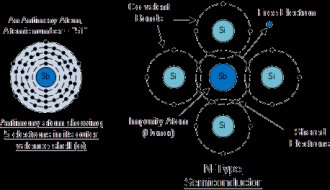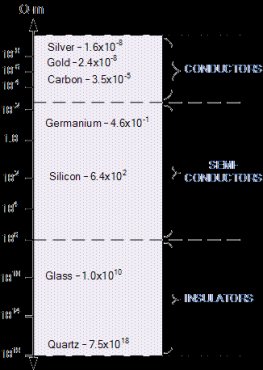![]() Generally speaking, most metals are good conductors of electricity, as they have very small resistance values, usually in the region of micro-ohms per metre. While metals such as copper and aluminium are very good conducts of electricity, they still have some resistance to the flow of electrons and consequently do not conduct perfectly.
Generally speaking, most metals are good conductors of electricity, as they have very small resistance values, usually in the region of micro-ohms per metre. While metals such as copper and aluminium are very good conducts of electricity, they still have some resistance to the flow of electrons and consequently do not conduct perfectly.
The energy which is lost in the process of passing an electrical current, appears in the form of heat which is why conductors and especially resistors become hot. Also the resistivity of conductors increases with ambient temperature because metals are also generally good conductors of heat.
Insulators
Insulators on the other hand are the exact opposite of conductors. They are made of materials, generally non-metals, that have very few or no “free electrons” floating about within their basic atom structure because the electrons in the outer valence shell are strongly attracted by the positively charged inner nucleus.
In other words, the electrons are stuck to the parent atom and can not move around freely so if a potential voltage is applied to the material no current will flow as there are no “free electrons” available to move and which gives these materials their insulating properties.
Insulators also have very high resistances, millions of ohms per metre, and are generally not affected by normal temperature changes (although at very high temperatures wood becomes charcoal and changes from an insulator to a conductor). Examples of good insulators are marble, fused quartz, p.v.c. plastics, rubber etc.
Insulators play a very important role within electrical and electronic circuits, because without them electrical circuits would short together and not work. For example, insulators made of glass or porcelain are used for insulating and supporting overhead transmission cables while epoxy-glass resin materials are used to make printed circuit boards, PCB’s etc. while PVC is used to insulate electrical cables as shown.
For example, insulators made of glass or porcelain are used for insulating and supporting overhead transmission cables while epoxy-glass resin materials are used to make printed circuit boards, PCB’s etc. while PVC is used to insulate electrical cables as shown.
Semiconductor Basics
Semiconductors materials such as silicon (Si), germanium (Ge) and gallium arsenide (GaAs), have electrical properties somewhere in the middle, between those of a “conductor” and an “insulator”. They are not good conductors nor good insulators (hence their name “semi”-conductors). They have very few “free electrons” because their atoms are closely grouped together in a crystalline pattern called a “crystal lattice” but electrons are still able to flow, but only under special conditions.
Price Disclaimer
The ability of semiconductors to conduct electricity can be greatly improved by replacing or adding certain donor or acceptor atoms to this crystalline structure thereby, producing more free electrons than holes or vice versa. That is by adding a small percentage of another element to the base material, either silicon or germanium.
On their own Silicon and Germanium are classed as intrinsic semiconductors, that is they are chemically pure, containing nothing but semiconductive material. But by controlling the amount of impurities added to this intrinsic semiconductor material it is possible to control its conductivity. Various impurities called donors or acceptors can be added to this intrinsic material to produce free electrons or holes respectively.
 This process of adding donor or acceptor atoms to semiconductor atoms (the order of 1 impurity atom per 10 million (or more) atoms of the semiconductor) is called Doping. The as the doped silicon is no longer pure, these donor and acceptor atoms are collectively referred to as “impurities”, and by doping these silicon material with a sufficient number of impurities, we can turn it into a semi-conductor.
This process of adding donor or acceptor atoms to semiconductor atoms (the order of 1 impurity atom per 10 million (or more) atoms of the semiconductor) is called Doping. The as the doped silicon is no longer pure, these donor and acceptor atoms are collectively referred to as “impurities”, and by doping these silicon material with a sufficient number of impurities, we can turn it into a semi-conductor.
The most commonly used semiconductor basics material by far is silicon. Silicon has four valence electrons in its outermost shell which it shares with its neighbouring silicon atoms to form full orbital’s of eight electrons. The structure of the bond between the two silicon atoms is such that each atom shares one electron with its neighbour making the bond very stable.
As there are very few free electrons available to move around the silicon crystal, crystals of pure silicon (or germanium) are therefore good insulators, or at the very least very high value resistors.
Silicon atoms are arranged in a definite symmetrical pattern making them a crystalline solid structure. A crystal of pure silica (silicon dioxide or glass) is generally said to be an intrinsic crystal (it has no impurities) and therefore has no free electrons.
But simply connecting a silicon crystal to a battery supply is not enough to extract an electric current from it. To do that we need to create a “positive” and a “negative” pole within the silicon allowing electrons and therefore electric current to flow out of the silicon. These poles are created by doping the silicon with certain impurities.
 A Silicon Atom Structure
A Silicon Atom Structure
The diagram above shows the structure and lattice of a ‘normal’ pure crystal of Silicon.
N-type Semiconductor Basics
In order for our silicon crystal to conduct electricity, we need to introduce an impurity atom such as Arsenic, Antimony or Phosphorus into the crystalline structure making it extrinsic (impurities are added). These atoms have five outer electrons in their outermost orbital to share with neighbouring atoms and are commonly called “Pentavalent” impurities.
This allows four out of the five orbital electrons to bond with its neighbouring silicon atoms leaving one “free electron” to become mobile when an electrical voltage is applied (electron flow). As each impurity atom “donates” one electron, pentavalent atoms are generally known as “donors”.
Antimony (symbol Sb) or Phosphorus (symbol P), are frequently used as a pentavalent additive to the silicon as they have 51 electrons arranged in five shells around their nucleus with the outermost orbital having five electrons. The resulting semiconductor basics material has an excess of current-carrying electrons, each with a negative charge, and is therefore referred to as an N-type material with the electrons called “Majority Carriers” while the resulting holes are called “Minority Carriers”.
When stimulated by an external power source, the electrons freed from the silicon atoms by this stimulation are quickly replaced by the free electrons available from the doped Antimony atoms. But this action still leaves an extra electron (the freed electron) floating around the doped crystal making it negatively charged.
Then a semiconductor material is classed as N-type when its donor density is greater than its acceptor density, in other words, it has more electrons than holes thereby creating a negative pole as shown.